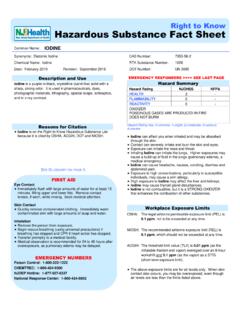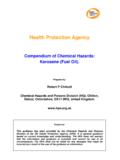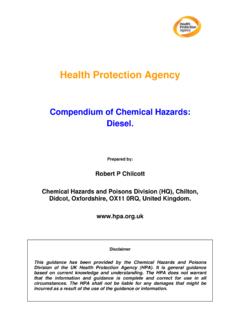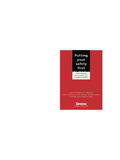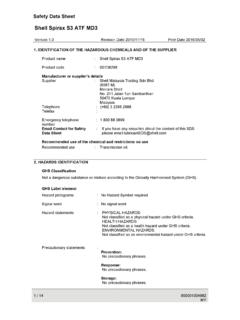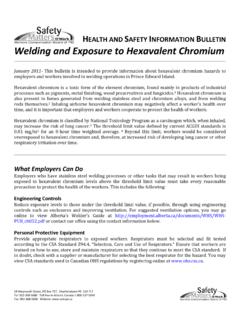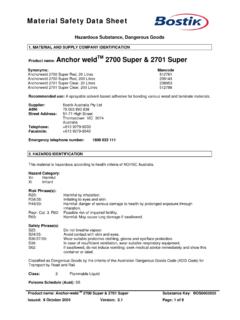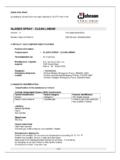Transcription of MATERIAL SAFETY DATA SHEET
1 Nycomed US Inc. MATERIAL SAFETY data SHEET . Prepared to OSHA, CMA, ANSI, and Canadian WHMIS. PART I What is the MATERIAL and what do I need to know in an emergency? 1. PRODUCT IDENTIFICATION. TRADE NAME/ MATERIAL NAME: Nitro-Bid . DESCRIPTION: Nitroglycerin Ointment NDC #: 0281-0326-08, 0281-0326-30, 0281-0326-60. CHEMICAL NAME (for active ingredients): 1,2,3-Propanetriol Trinitrate CHEMICAL FAMILY (for active ingredient): Aliphatic Polyhydric Alcohol Derivative HOW SUPPLIED: Ointment FORMULA (for active ingredient): C3H5N3O9. PRODUCT USE: Pharmaceutical for Human Use SUPPLIER/MANUFACTURER'S NAME: NYCOMED US INC. (Savage Labs Division). ADDRESS: 60 Baylis Road Melville, NY 11747. BUSINESS PHONE/GENERAL MSDS INFORMATION: 1-631-454-7677. EMERGENCY PHONE ( Rico): 1-800-424-9300 (24-hr). EMERGENCY PHONE (OUTSIDE ): + 1-631-454-7677. NOTE: ALL United States Occupational SAFETY and Health Administration Standard (29 CFR ), State equivalent Standards, and Canadian WHMIS [Controlled Products Regulations] required information is included in appropriate sections based on the ANSI format.
2 This product has been classified in accordance with the hazard criteria of the countries listed above. 2. HAZARD IDENTIFICATION. EMERGENCY OVERVIEW: Product Description: This product is a pale yellow ointment with a mild petroleum jelly and lanolin odor. Health Hazards: The chief health hazard associated with exposure during normal use and handling is the potential for irritation of contaminated skin. Individuals who have had allergic reactions to products containing the active ingredient, Nitroglycerin, other organic nitrates, the Lanolin component or any other components of this product may experience allergic reactions to this product. Flammability Hazards: This product must be substantially heated for ignition to become a hazard. When involved in a fire, this MATERIAL may decompose and produce irritating vapors and toxic compounds (including carbon oxides and nitrogen oxides).
3 Reactivity Hazards: This product is not reactive. Environmental Hazards: This product has not been tested for environmental effects. Emergency Considerations: Emergency responders should wear appropriate protection for situation to which they respond. 3. COMPOSITION and INFORMATION ON INGREDIENTS. CHEMICAL NAME CAS # % w/w Nitroglycerin 55-63-0 Water 7732-18-5 Proprietary Lactose 63-42-3 Proprietary White Petrolatum 8009-03-8 Proprietary Lanolin 8006-54-0 Proprietary PART II What should I do if a hazardous situation occurs? 4 FIRST-AID MEASURES. Persons developing hypersensitivity reactions should receive medical attention. If breathing is difficult, give oxygen. If not breathing, give artificial respiration. Take a copy of label and MSDS to physician or health professional with the contaminated individual. SKIN EXPOSURE: If adverse skin effects occur, discontinue use.
4 Seek medical attention. EYE EXPOSURE: If this product contaminates the eyes, rinse eyes under gently running water. Use sufficient force to open eyelids and then "roll" eyes while flushing. Minimum flushing is for 15 minutes. The contaminated individual must seek medical attention if any adverse effect continues after rinsing. INHALATION: If vapors of this product are inhaled, causing irritation, remove victim to fresh air. If necessary, use artificial respiration to support vital functions. Seek medical attention if adverse effect continues after removal to fresh air.. NITRO-BID MSDS EFFECTIVE DATE: OCT 14, 2010. PAGE 1 OF 10. Nycomed US Inc. 4 FIRST-AID MEASURES (Continued). INGESTION: If this product is swallowed, CALL PHYSICIAN OR POISON CONTROL CENTER FOR MOST CURRENT. INFORMATION. If professional advice is not available, do not induce vomiting. Never induce vomiting or give diluents (milk or water) to someone who is unconscious, having convulsions, or unable to swallow.
5 If victim is convulsing, maintain an open airway and obtain immediate medical attention. MEDICAL CONDITIONS AGGRAVATED BY EXPOSURE: Pre-existing skin conditions may be aggravated by repeated overexposures to this product. RECOMMENDATIONS TO PHYSICIANS: This product should only be given to patients by persons experienced in management of patients receiving the type of therapy intended for this product. Because the hypotension associated with nitroglycerin overdose is the result of venodilatation and arterial hypovolemia, prudent therapy in this situation should be directed toward increase in central fluid volume. Passive elevation of the patient's legs may be sufficient, but intravenous infusion of normal saline or similar fluid may also be necessary. The use of epinephrine or the arterial vasoconstrictors in this setting is likely to do more harm than good.
6 Methemoglobin levels are available from most clinical laboratories. The diagnosis should be suspected in patients who exhibit signs of impaired oxygen delivery despite adequate cardiac output and adequate arterial pO2. Classically, methemoglobinemic blood is described as chocolate brown, without color change on exposure to air. When methemoglobinemia is diagnosed, the treatment of choice is methylene blue, 1 2 mg/kg intravenously. 5. FIRE-FIGHTING MEASURES. FLASH POINT (closed cup): > 110 C (230 F). AUTOIGNITION TEMPERATURE: Not established. NFPA RATING. FLAMMABLE LIMITS (in air by volume, %): FLAMMABILITY. Lower (LEL): Not applicable. Upper (UEL): Not applicable. FIRE EXTINGUISHING MATERIALS: Use extinguishing media appropriate for surrounding fire. 1. Water Spray: OK Carbon Dioxide: OK. Foam: OK Dry Chemical: OK HEALTH 2 1 INSTABILITY. Halon: OK Other: Any "ABC" Class FIRE EXTINGUISHING MATERIALS NOT TO BE USED: None known.
7 UNUSUAL FIRE AND EXPLOSION HAZARDS: This product must be OTHER. substantially heated for ignition to become a hazard. When involved in an intense fire, this MATERIAL may decompose and produce irritating vapors Hazard Scale: 0 = Minimal 1 = Slight 2 = Moderate and toxic compounds (including carbon oxides and nitrogen oxides). 3 = Serious 4 = Severe Less intense smoldering-type fires can cause Nitroglycerin to migrate and collect, leading to an explosion if sufficient heat is present. The Nitroglycerin component of this product is a powerful explosive and separation of it from the ointment vehicle is extremely hazardous. This product contains a known skin sensitizer, and so it poses a contact hazard to firefighters. Explosion Sensitivity to Mechanical Impact: Not sensitive. Explosion Sensitivity to Static Discharge: Not sensitive. SPECIAL FIRE-FIGHTING PROCEDURES: Incipient fire responders should wear eye protection.
8 Structural firefighters must wear Self-Contained Breathing Apparatus (SCBA) and full protective equipment. If protective equipment is contaminated by this product, it should be thoroughly washed with running water prior to removal of SCBA respiratory protection. Firefighters whose protective equipment becomes contaminated should thoroughly shower with warm, soapy water and should receive medical evaluation if they experience any adverse effects. 6. ACCIDENTAL RELEASE MEASURES. SPILL AND LEAK RESPONSE: Proper protective equipment should be used. In the event of a spill, clear the area and protect people. The atmosphere must have levels of components lower than those listed in Section 8, (Exposure Controls and Personal Protective Equipment) if applicable, and have at least percent oxygen before personnel can be allowed into the area without Self-Contained Breathing Apparatus (SCBA).
9 Small Spills: Wear goggles and gloves while wiping up small spills of this product with polypad or sponge. Large Spills: Trained personnel following pre-planned procedures should handle non-incidental releases. Access to the spill areas should be restricted. Protective apparel should be used with a respirator when there is any danger of mists or sprays being generated. Minimum Personal Protective Equipment should be rubber gloves, rubber boots, face shield, and Tyvek suit. Dispersing mists or sprays into surrounding air and possibly inhaling them is a serious matter and should be treated as such. Minimum level of personal protective equipment for releases in which the level of oxygen is less than or is unknown must be Level B: triple-gloves (rubber gloves and nitrile gloves over latex gloves), chemical resistant suit and boots, hard hat, and Self-Contained Breathing Apparatus.
10 Absorb spilled liquid using polypads or other suitable absorbent MATERIAL .. NITRO-BID MSDS EFFECTIVE DATE: OCT 14, 2010. PAGE 2 OF 10. Nycomed US Inc. 6. ACCIDENTAL RELEASE MEASURES (Continued). SPILL AND LEAK RESPONSE (continued): Large Spills (continued): Prevent MATERIAL from entering sewer or confined spaces, waterways, soil or public waters. Monitor area and confirm levels are bellow exposure limits given in Section 8 (Exposure Controls-Personal Protection), if applicable, before non- response personnel are allowed into the spill area. Decontaminate the area of the spill thoroughly using detergent and water. Place all spill residue in an appropriate container and seal. Dispose of in accordance with applicable Federal, State, and local procedures (see Section 13, Disposal Considerations). PART III How can I prevent hazardous situations from occurring? 7.
